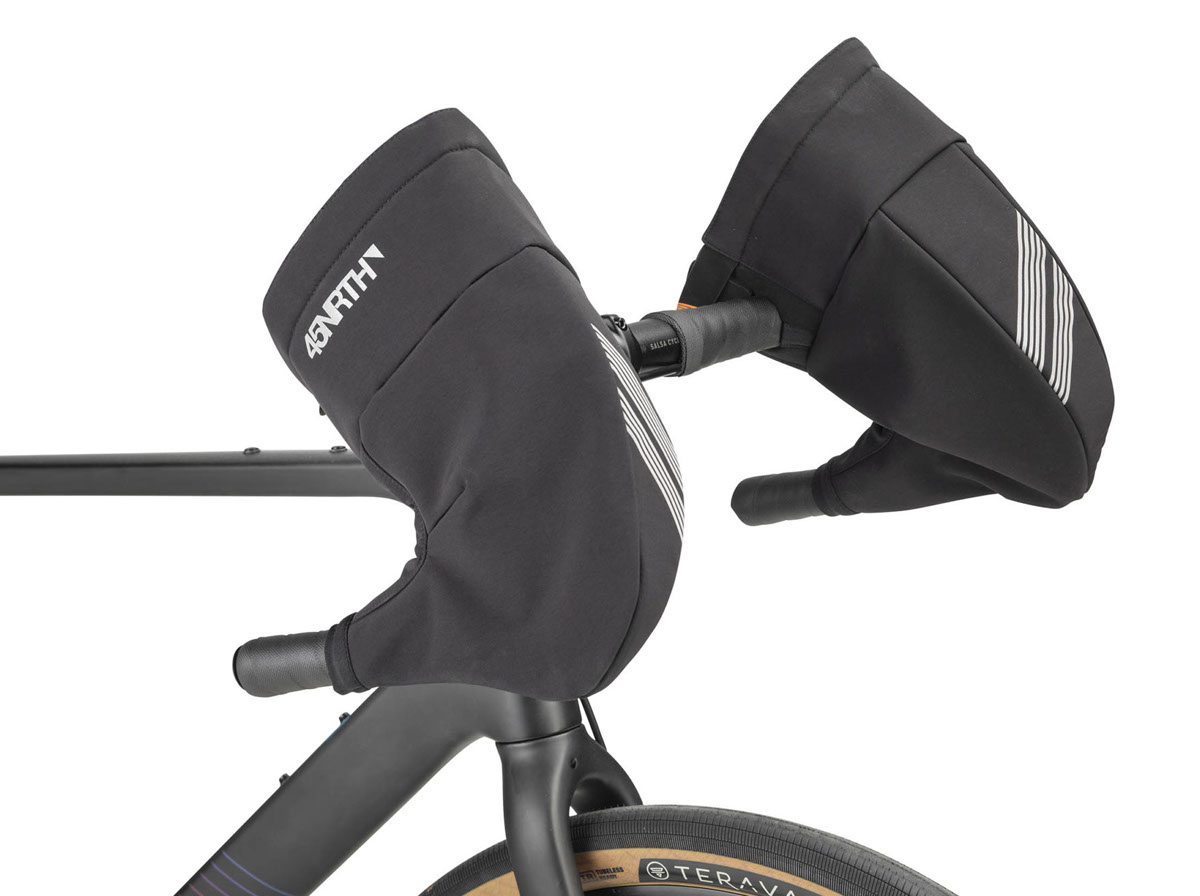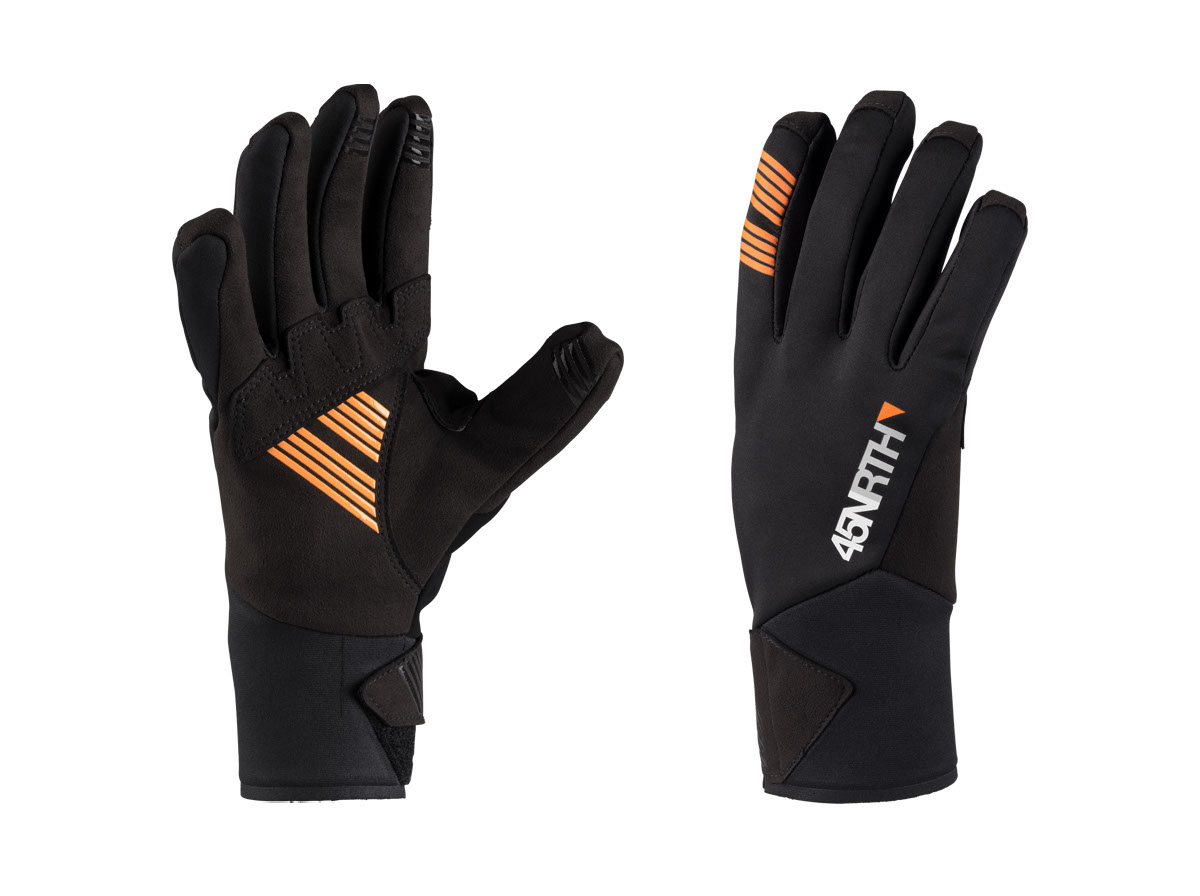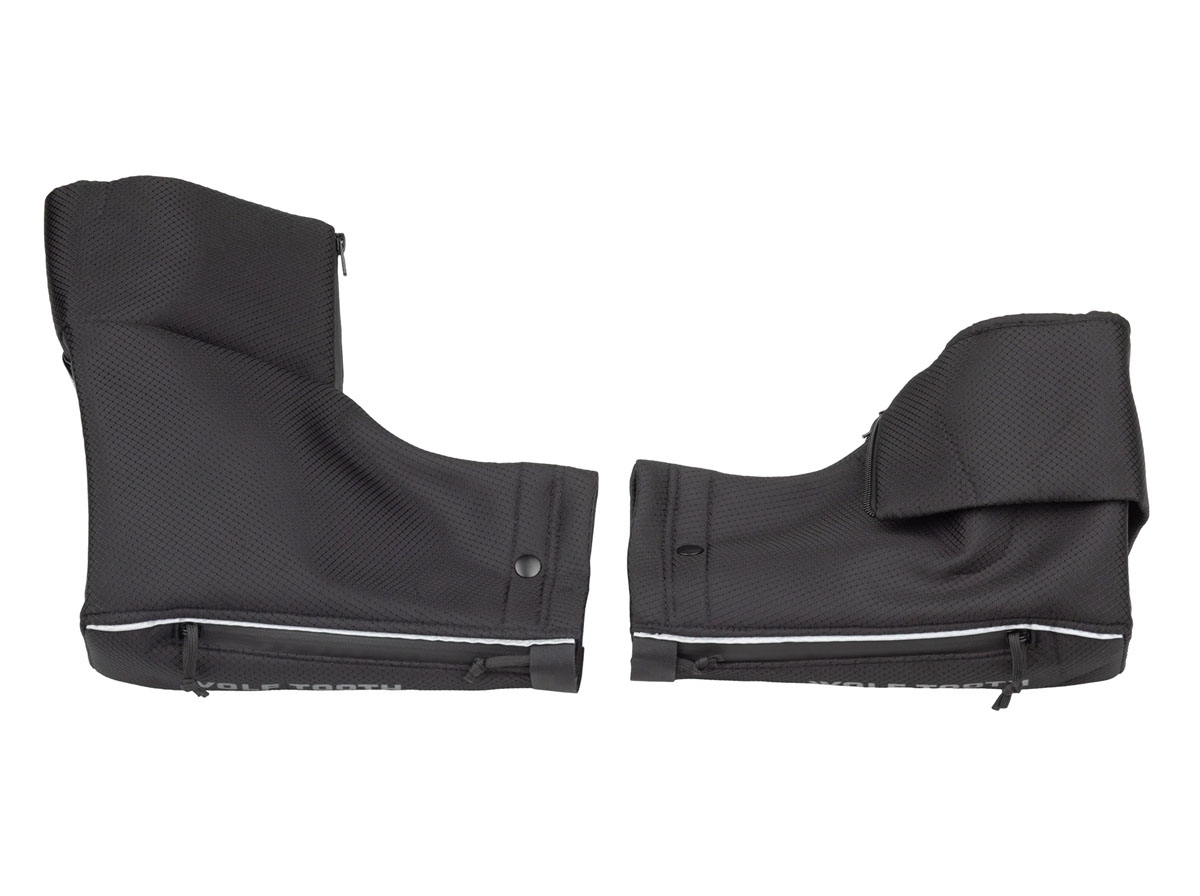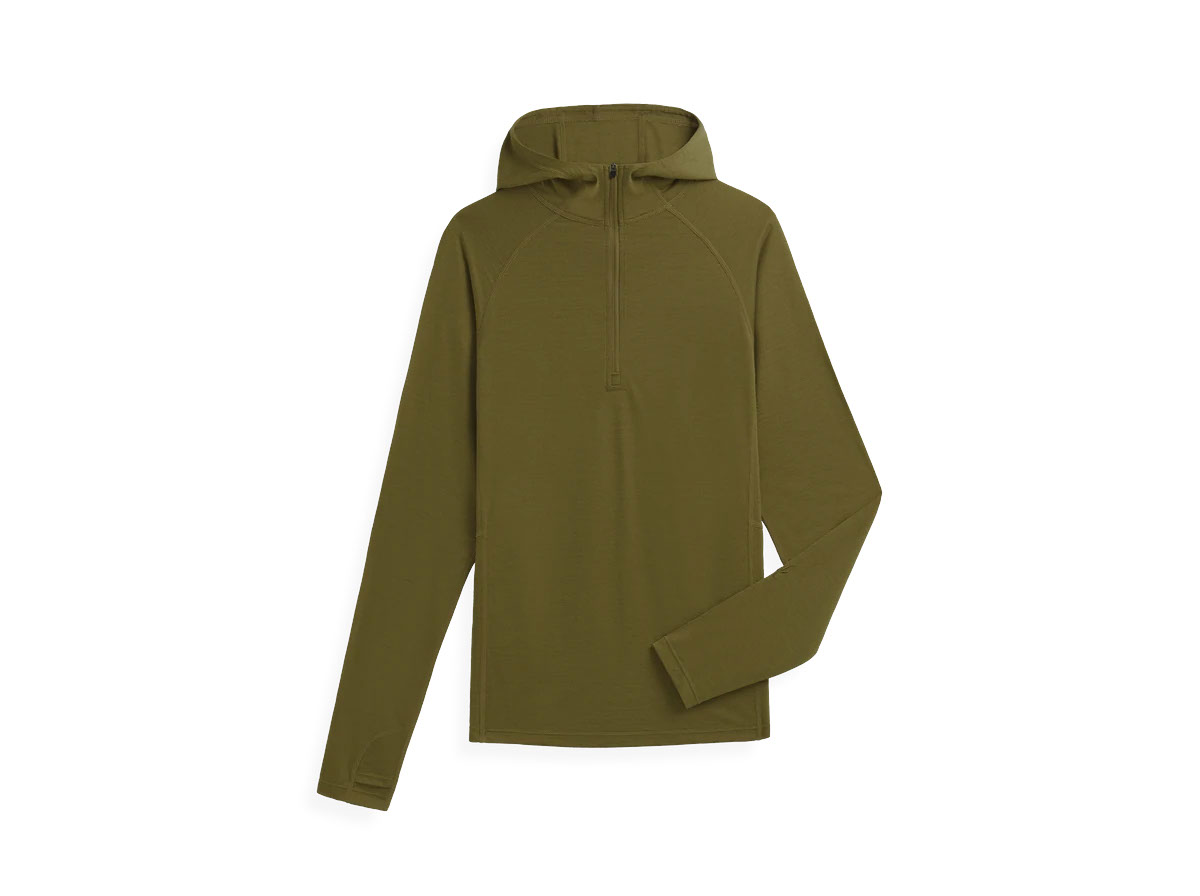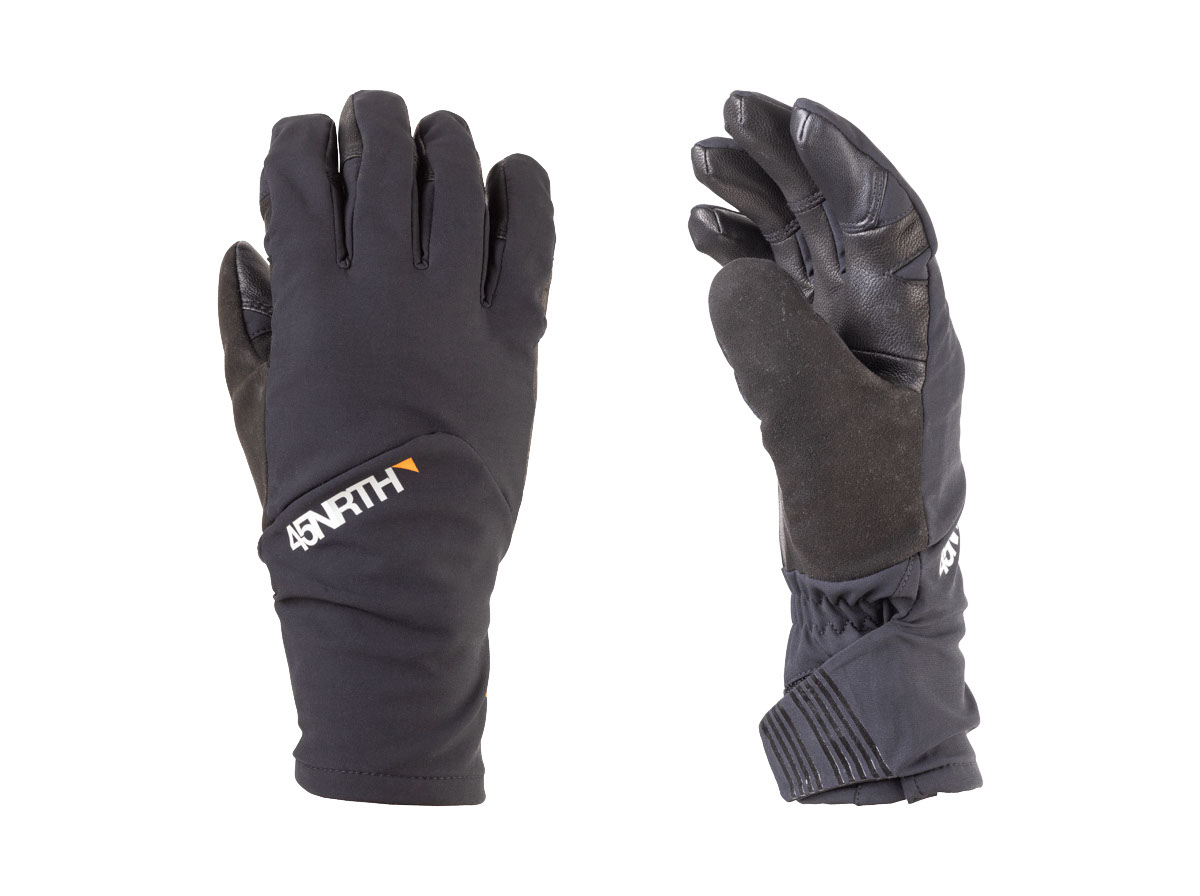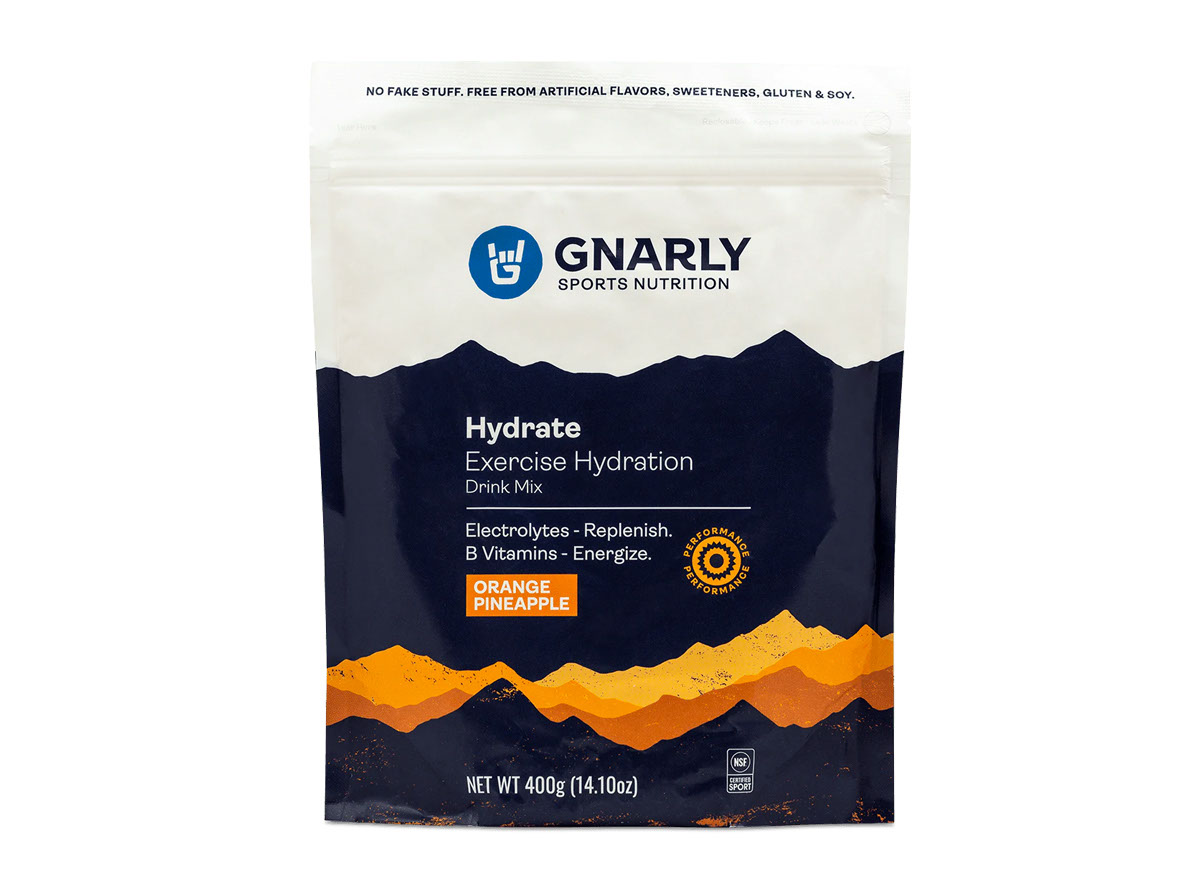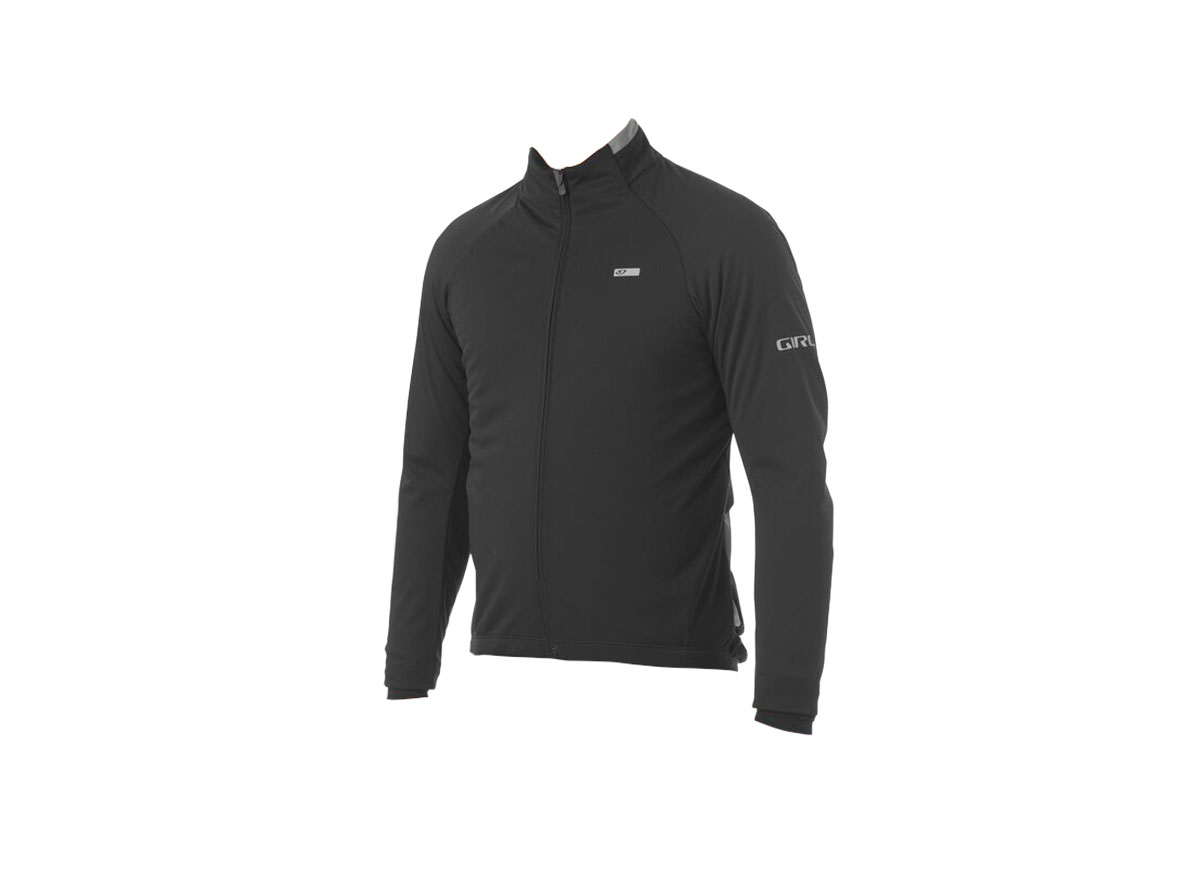Geared Up: Staying Warm in Winter
45NRTH Draugenklaw Dropbar Pogies, $85
Every winter, I dream, and then talk myself out of, pogies (hand covers that attach to handlebars and cover the grips and brake levers). The first reason is that they can be a bit pricey, the second is that for a long time most of my bikes had dropbars, and the third is my spirited attempt to ignore winter until it goes away. Once I got pogies for my RadWagon and realized there was life beyond barely holding onto the handlebars and then whimpering as my hands went through the thawing process upon returning home, I could put up less of a fight with myself over the concept. When I saw the ad for 45NRTH’s new Draugenklaw Dropbar Pogies, I was excited to give them a try. They aren’t the only dropbar pogie on the market by any stretch, but 45NRTH is a trusted brand and they had my attention. The Draugenklaw took a bit of getting used to for someone who isn’t quite used to pogies in general. They are a rather tight fit on the hoods, which is fine for a person like me with small-ish hands, but as one of my hoods is larger than the other, I found one of them to be rather snug and I had to keep adjusting the pogie to keep it from sliding down. Additionally, it took some adjustments to get the housing from the right brifter into a good spot where the pogie stayed on and wasn’t wedged down by the housing, but once I finessed it into place it was very comfortable. I should also note that I ride flared dropbars and that will add to the tightness somewhat, so if you have medium-large hands and ride traditional dropbars with average-sized hoods, I think these should fit just fine. This winter has swung like a pendulum between 50°F days and -10°F evenings, and having a set of lightweight pogies on my winter ride has been great. On the warmer days, I go glove-less and appreciate the soft lining of the pogies, as opposed to a wet or clammy neoprene. On those exceptionally cold mornings when I’m riding into the office, I grab my warm gloves and feel as toasty as can be (the range for these pogies is 15°F–35°F, so they are meant for relatively mild winter conditions). These pogies may not hit it out of the park for everyone, but they sure kept me riding during my first winter in Montana, and that’s saying something. –Carolyne Whelan
45NRTH Nøkken Lightweight Gloves, $65
I got these thin winter gloves specifically to pair with pogies, but I’ve found them to be great all-around mild-weather gloves. They are thin enough to keep tucked away somewhere (handlebar bag, backpack, deep pocket) just in case temps drop, but warm enough to keep my hands in good shape. The merino wool makes them very comfortable to wear, and it’s easy to want to just throw them on any time it’s chilly. I do love them with the pogies because their thin profile makes the rather tight fit of the Draugenklaws a non-issue, but they’re also the gloves I grab on any day above 25°F when I am walking the dog or plan on throwing snowballs — the rather long neoprene cuff turns out to be primo snow protection for when a retriever mix can’t wait any longer and comes for the snowball before it’s thrown. When I am riding a short commute, or when the temperature drops below 15°F or so, these gloves aren’t quite warm enough with the pogies. But even on cold evening rides up the mountain with studded tires, I was warm enough with these gloves and the pogies despite the temperature dropping down to the single digits (without a warmer pair of gloves, though, I stayed glued to the post-ride campfire). The website said they are touchscreen compatible, and maybe it’s because I had extra room in my fingertips but I had a very hard time turning that into reality. I also found the nose wipe area not as large or absorbent than I’d like, but that probably says more about me than the gloves, sadly. They are rated for 25°F–45°F, not including pogies, so if you don’t have pogies and live in a colder climate, I recommend keeping these as a shoulder season pair. Otherwise, they have been a great help this winter. –CW
Wolf Tooth Singletrack Pogies V2, $120
I first reviewed Wolf Tooth’s original, made-in-the-U.S. Singletrack Pogies long ago, in 2017, and I loved them. After the Minneapolis company made some improvements and moved production overseas, former Editor-in-Chief Alex Strickland reviewed the updated version in 2019 and, yes, he loved them. Now, Wolf Tooth has made further improvements to create the V2 (V3?) Singletrack Pogies, which just might be the best yet.
Like the previous versions, the new Singletrack Pogies retain Wolf Tooth’s ingenious three-stage warmth settings: cuff folded down for warm, cuff up for warmer, and cuff up and zipped for warmest, making these pogies highly versatile. The new version also keeps the side stiffeners and adds a softer, fleecier interior for more warmth, front zips for venting, and reflective piping for visibility. They’re warm enough that, on chilly 20°F mornings, I rode in my summer gloves, starting with the cuff up and zipped while I warmed up and eventually folding the cuff down and opening the vents to keep my hands from sweating. I could even comfortably ride with bare hands in below-freezing temperatures. Keep in mind that these pogies are intended for high-output pedaling in relatively mild winter weather. If you’re commuting, cruising, or riding near the Arctic Circle, you may want to look for something warmer.
With the included quarter-turn bar plugs, the Singletrack Pogies are quick and easy to install, and acquiring an extra set of plugs ($25) means you can swap the pogies from bike to bike in just a couple of minutes. And because these pogies fold flat, they’re easy to stow in a framebag or backpack, which is great for shoulder-season bikepacking trips in which you might come across unexpectedly cold temperatures or surprise snow (ask me how I know). –Dan Meyer
Ibex Indie Hoodie, $170
It was a sad day when, way back in 2017, merino wool apparel brand Ibex shut down. I have two legacy Ibex long-sleeve shirts that are still my favorite pieces of clothing, and it would have been too bad if I could never buy another. Lucky for merino fans everywhere, Ibex came back two years later, this time with a commitment to producing the same high-quality clothing ethically and sustainably.
The Indie Hoodie is proof positive that the new Ibex hasn’t lost the magic of the original. With an under-helmet hood, quarter-zip, and nice long sleeves with thumb holes, the Indie Hoodie is a great do-anything layer. I wore it camping in the mountains, mountain biking in the desert, and even snowboarding in the backcountry, and the Indie excelled at it all. Like my legacy shirts, the Indie was comfortable all day long and proved highly resistant to stink (no small feat, let me assure you), which is maybe the best argument for investing in a piece of quality clothing like this. And yes, at $170, this shirt is an investment, but if it’s anything like the Ibex of yore, it should last for years and years. And it’s both 100 percent merino wool and machine washable, which isn’t as common a combo as you’d think. If I have to nitpick, I would wish for another inch or two in back length for easier tucking and more coverage while cycling, but then it isn’t a cycling-specific garment. I would put the Indie Hoody between lightweight and midweight in terms of warmth; I wouldn’t wear it in the middle of summer, but it will be my first pick for bikepacking trips this spring and for winter and shoulder-season activities from now on. –DM
45NRTH Sturmfist 5 Winter Gloves, $115
I would expect by now that I would have the most ultimate pair of gloves out there. Maybe that’s a fool’s errand, or maybe I’m hoping fate will throw a pair of perfect gloves into my lap. The Sturmfist 5s aren’t the warmest on the market, but gosh darnit are they comfortable. These, like the Nøkkens, are lined with merino wool, and I find myself rather creepily wiggling my fingers inside the roomy gloves to feel that softness. My expectations for these gloves were tilted, so I’ll adjust yours now: they are spec’d for 15°F–35°F. So if you throw them on to walk for a coffee when it’s -3°F out, it’s not the gloves’ fault that your hands are cold. That said, I did do that many times with these gloves and they weren’t exactly overheating, but they stayed comfortable and that’s a first for me. These gloves are a bit bulky — they’re winter gloves, after all — but they honestly didn’t feel too bad on my hands; I had all the dexterity I needed to to shift, brake, or shake my fist at a driver who cut me off. On longer rides in the snow, where my body temperature was increasing, these gloves really shined. The nylon shell kept me dry and protected from wind, and, again, that dreamy merino wool liner kept me dry and cozy. On exceptionally cold days with a short commute, I used these with my pogies and they worked like a charm. I think riding with these gloves and pogies for more than a few miles may be a bit excessive and cause overheating, but for a short ride, these gloves paired with pogies of the same suggested temperature range really increased the rideability considerably. Where I think these gloves really shine though is out in the open, protecting from yucky weather, whether it’s a cold and rainy day or one of those brutally windy days where the wind chill cuts the feels-like temperature in half. On those rides, these gloves really saved my digits. –CW
Gnarly Nutrition Hydrate, $27 for 40 servings
With how hot Salt Lake City gets, I’m strictly religious about using electrolyte powder in the summer, but I get pretty complacent about it when the weather cools down. You can’t get dehydrated in the winter, right? Wrong. Luckily, Gnarly Nutrition’s Hydrate mix has tons of electrolytes and only a little bit of sugar (way less sugar, in fact, than my usual go-to mix). I tried both the Orange Pineapple and Raspberry flavors, and I preferred the more subtle Orange Pineapple during rides and saved the Raspberry for post-ride hydration (Ruby Red Grapefruit is also available). Both flavors made my tummy happy, which I can’t say for every electrolyte mix out there. Gnarly Nutrition is also vegan and gluten-free. –DM
Giro Chrono Pro Alpha Jacket, $275
If you enjoy road riding in the middle of winter — as in serious winter, with snow and ice and whatnot — you need a serious winter jacket. Giro’s Chrono Pro Alpha is not messing around, not with Windbloc fabric and Alpha insulation from Polartec, it’s not. Giro doesn’t list a temperature rating for the Chrono Pro, but I would rate it as Very Warm. If you run a bit hot like I do, the Chrono Pro might be a smidge too warm for anything above freezing, depending on what you’re wearing for a baselayer. I typically wore either a thin merino baselayer or a long-sleeve jersey, and I found the jacket to be perfect in temperatures between 15°F and 32°F (I did not ride when it was below 15°F; I have my limits). In spite of its warmth, the Chrono Pro breathes pretty well — you can feel the air moving through the side panels — but even so, I had to unzip a little for extended climbs.
The Chrono Pro’s fit is fairly tight; I wore a size medium and didn’t have much room for thick layers underneath, not that I needed them. It has three expandable rear pockets and a zip pocket in the middle, as well as reflective details throughout to keep you visible to traffic on those cold, dark morning rides. The one miss I found on the Chrono Pro was the wrist cuffs with thumb holes. They’re a great idea for a winter jacket, but I found them way too tight. After 10 minutes, I had to stop and pull my hands out of them lest I lose the feeling in my thumbs. Minor quibbles aside, the Giro Chrono Pro is a great jacket to keep you outside and pedaling year-round. –DM
